Two New Ions: ASUS AT3N7A-I and ASRock Ion 330
by Anand Lal Shimpi on August 28, 2009 12:00 AM EST- Posted in
- Motherboards
The first companies to support non-Intel products are those that have the weakest relationships with Intel. How Intel is able to ensure this is the crux of the AMD v. Intel antitrust suit, but that’s not the point of today’s story.
NVIDIA’s Ion platform, at least when first introduced, combined Intel’s Atom CPU with NVIDIA’s GeForce 9300/9400M integrated graphics chipset. This offered better performance and modern features compared to Intel’s 945G chipset, what Intel was bundling with Atom. Intel still sold the CPUs but it lost the chipset sale and got upstaged by NVIDIA. Intel doesn’t like being upstaged by anyone.
Intel’s partners are very cautious when supporting a product like Ion. They don’t want to appear too eager and thus Intel’s closest partners wait to see if a product like Ion succeeds before attempting to jump on the bandwagon.
Zotac built the first mini-ITX Ion motherboard. While Zotac builds several Intel motherboards, they are hardly considered a tier 1 motherboard manufacturer. Zotac doesn’t get preferential treatment by Intel and thus Zotac doesn’t have to worry about ruffling any feathers by releasing an Ion motherboard.
I can’t tell you how well the Zotac Ion has sold, but reading our review and user experiences with the board I can tell you that customers are pleased. It’s a good product and it fills a niche that Intel currently has no answer to. I’m not even sure if Pine Trail will address that market either.
ASUS was Intel’s launch partner for Atom. The first place you found the Atom processor was in ASUS’ Eee PC and Eee Box. The rest of the OEMs followed. It’s no surprise that ASUS didn’t build an Ion motherboard or an Ion netbook for that matter.
ASUS tested the waters with its value manufacturing brand earlier this year. ASRock put out an Ion system based on the Intel Atom 330 processor; note the use of the word system. The ASRock Ion differed from the Zotac Ion motherboard in that it was a barebones system complete with mini-ITX chassis, external power supply, 2GB of RAM, slim optical drive and 320GB hard drive. All you needed to add was an OS.
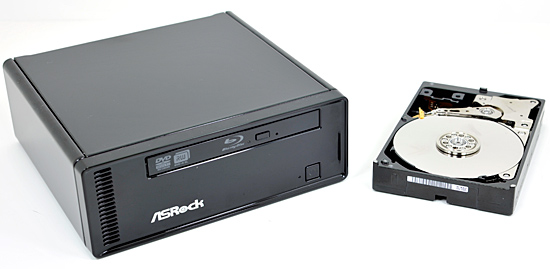
The ASRock Ion 330 (left) vs. a 3.5" HDD (right). We're not too far away from having P4-class PCs in the space of a hard drive.
The whole package sets you back $379.99 (ASRock does charge a slight premium for building the thing).
A couple of weeks ago we got word that the second mini-ITX Ion motherboard was coming our way. The manufacturer? ASUS. Ballsy.
Unlike the ASRock and Zotac Ion solutions, ASUS gave its Ion board a real and unnecessarily complex name. This is the AT3N7A-I:

Also gone is the North American favorite “Rock Solid, Heart Touching” phrase on the box. Instead we’re given two new slogans: Inspiring Innovation, Persistent Perfection (hooray for alliteration) and Perfectly suit your digital lifestyle.
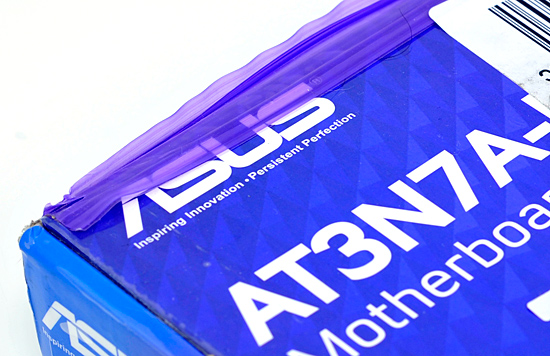
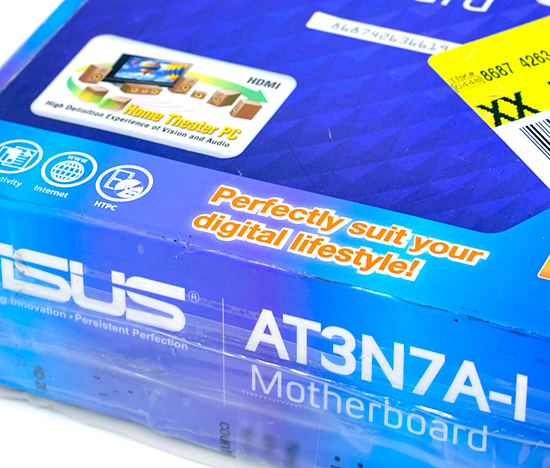
A Closer Look at the ASUS AT3N7A-I
ASUS’ Ion board doesn’t come with a power supply, it instead has a 24-pin ATX power supply connector and a 4-pin 12V connector for CPU power. The ASUS Ion is eerily similar to the Zotac board but with poorer color choices.
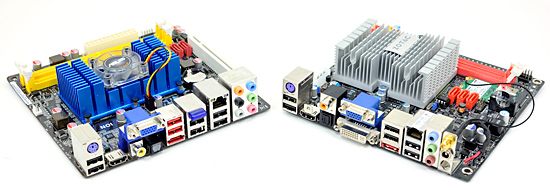
Zotac’s board has on-board WiFi, while ASUS’ board has on-board Bluetooth.

ASUS (left) vs. Zotac (right)
ASUS adds a ton more USB ports on the rear of the AT3N7A-I. You get a total of 8 USB ports (+2 more via an internal header), a single PS2 port, HDMI out, VGA out, coax/optical out, eSATA, Ethernet and the standard array of six 1/8” jacks for analog audio out.
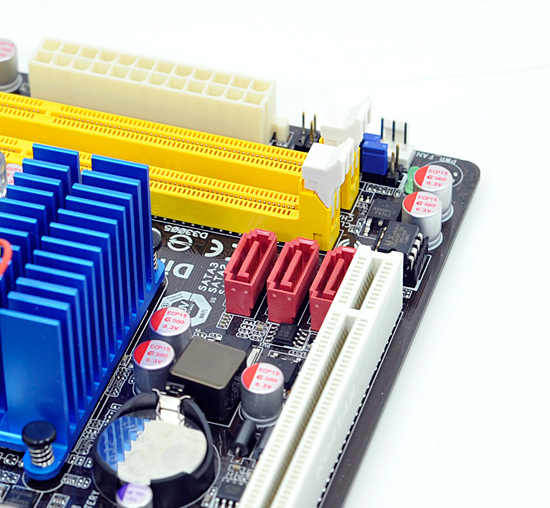
On the board itself there are three SATA ports, like the Zotac board, but ASUS also adds a standard 32-bit PCI slot (not PCIe).
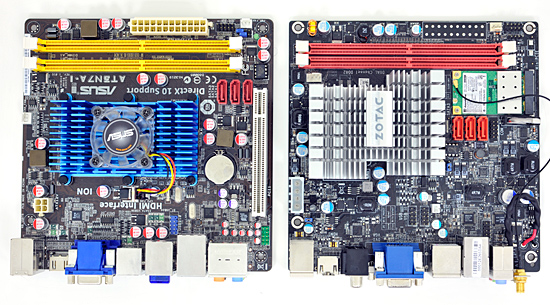
ASUS (left) vs. Zotac (right)
Two DIMM slots round out the package.










61 Comments
View All Comments
Visual - Monday, August 31, 2009 - link
I'd really like to hear Anand's take on how these ion things compare with what's possible to build using nano-itx and via, mini-itx and amd or non-atom intel, and even the latest mac mini which appears to be smaller than any of these while with much better video card.Pandamonium - Monday, August 31, 2009 - link
Adobe needs to get GPU-acceleration working on Flash. The next Atom (due Q1/2010) doesn't seem like it'll be terribly faster than the N330. The new D510 looks to be different only in clockspeed @ 1.66 GHz vs the N330's 1.6 GHz. So the choices look like:1) Wait around for another year waiting for the holy grail of HTPC guts
2) Buy a $500 Mac Mini and put a ~$400 slot loading Blu-Ray drive inside it
3) Adobe can fix Flash
All I want is something I can stick in a TV stand with minimal ventilation (think glass door) that can handle Hulu, Netflix, and Blu-Ray. Sigh.
ekerazha - Saturday, August 29, 2009 - link
What's the exact model of the ASRock rear fan? And its max speed? Thank you.dawp - Saturday, August 29, 2009 - link
I just curious as to how the nano compares to the atom preformance wise.QChronoD - Friday, August 28, 2009 - link
I'm getting fed up with having half my files not want to play on either my PS3 or 360 (and its a pain to have to "record" them to my TiVo, which is almost always full).I was looking at getting one of the Popcorn Hours, but this seems like it would be a really good alternative. It may cost a bit more, but then I would have a full computer if I needed it.
I would love to see an article that really covered the different devices for getting our media onto a TV. There's lots of reviews for each box that I've seen, but haven't really come across any good roundups that also compare them with HTPC software.
Smeezy101 - Friday, August 28, 2009 - link
I can say that XBMC Live works great on the Zotac board. FYI, I'm using my build with the following case:http://www.mini-box.com/M350-universal-mini-itx-en...">http://www.mini-box.com/M350-universal-mini-itx-en...
Obviously, there is no room for an internal dvd/bluray drive but I use this box strictly for pulling media off of my Windows Home Server. It streams 1080p files (m2ts with AC3 or DTS) with no hiccups what-so-ever. The only downside is that XBMC doesn't support the HD audio codecs so any blu-ray rips need to have the audio down-converted.
yyrkoon - Friday, August 28, 2009 - link
While I have never had an xbox360, or have used one. A friend of mine tells me he uses his as a media extender.My understanding of this is that he just uses it to feed media to his different TVs throughout his house. So, in other words, the xbox360 is not doing any decoding, just displaying the networked media on the different TVs. The streaming sever of course is a PC located in a different room.
Is this what you're currently doing ? I do agree though XBMC looks really nice for a Linux media player ( distribution? ).
yyrkoon - Friday, August 28, 2009 - link
it was very thorough except on one aspect that I can think of;While I do understand that it could be difficult to procure a good low power power supply in the ATX form factor, I feel that you guys did not pursue the matter as well as you could have. First, I am not sure if you understand that any power supply is best loaded at 50% for optimal efficiency, and that there is at least the Sparkle 220W 80Plus PSU available on the market. Provantage sells them . . . With that said however, while it would most likely drop the power consumption of the Asus platform, it would likely not be low enough for optimal efficiency. Which brings me to my next point.
There are not very many low power power supplies on the market. At least not in the context of extremely low powered systems. There are a few external "brick" based PICO power supplies around, a few "low powered" ATX supplies, and probably several OEM specific specialty supplies as well. This is not enough for people who build their own system, and you would think the Power supply industry would be keen to pick up on this.
As it stands, your Asus ION system does not do any better than the System ZDNets tech writer George Ou tested a while back when he was still writing for ZDNet. He used standard off the shelf parts with an Intel Core 2 E2140 ( I believe ) that used 49W under full load *INCLUDING* a LCD monitor. The power supply he used was the Sparkle 220W 80 Plus PSU I mentioned above. His conclusion as I recall was that *if* he could have found a better, lower powered 80 Plus PSU, that this system could have achieved even better power consumption numbers. He did try a PICO supply in another article, but found it unacceptable for one reason or another. Of course this was back in 2007, and things *could* have changed by then, but nothing that I am personally aware of.
I think that we all are well aware of the fact that the E2140 system would blow the doors off of any ION system. Except obviously for the Intel GMA 3100 graphics.
Anyways, it is my hope that user like myself bringing this information to you is that somehow you could relay this information to the OEMs/ODMs so "we" can actually get what we need. Someday.
yyrkoon - Friday, August 28, 2009 - link
Sorry . . . link below to this short write up for those interested.http://blogs.zdnet.com/Ou/?p=934">http://blogs.zdnet.com/Ou/?p=934
If you browse through his write ups, you will find the article where he tested this system ( or was it another ? ) with a PCIO supply, and found it unacceptable for his needs.
pantherman007 - Friday, August 28, 2009 - link
The ASRock would be a perfect HD HTPC setup, *IF* they had included an IR receiver. Yes, I could add a USB IR receiver, but then there's another box and cord involved.The minute that I found an ION-based product in a case the size of the ASRock that has built-in IR, I'll buy three.